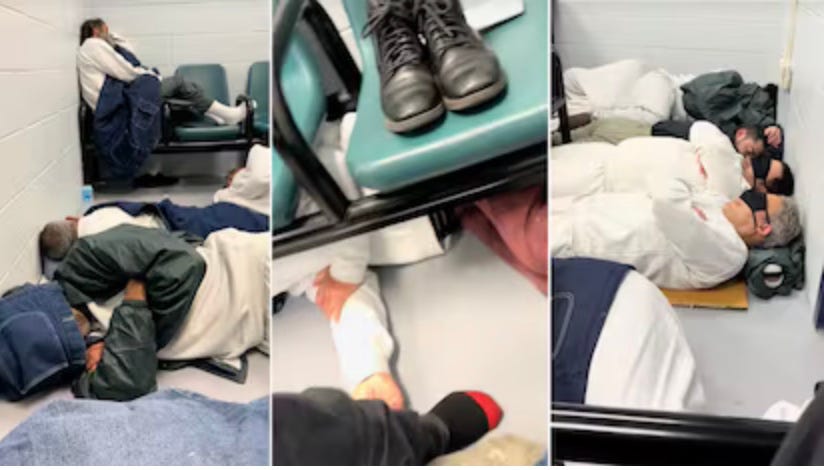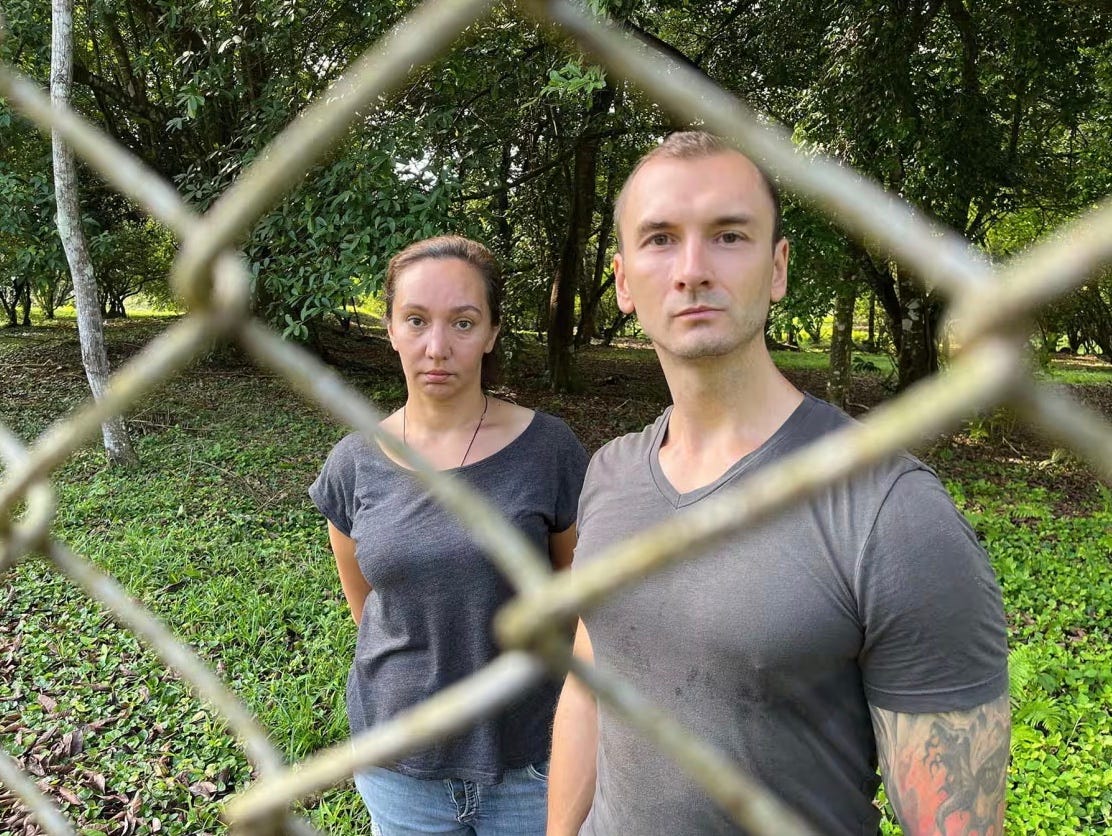More Deportables (Pt. 2 of 2): A deeper look at ICE detainees who recently died and what's happened to deportees in Central America.
As more detainees bear witness to deplorable conditions in ICE detention centers, three tragic recent deaths merit our focus and raise important questions.
South Florida protesters dangerous conditions at ICE Krome facility, March 28
Jose Iglesias |Miami Herald
This is Part 2 of a 2-part series. See Part 1 for updates on More Deportables and details on Trump’s expansion of deportation to new targets.
In this issue:
Three Deaths of ICE Detainees Raise Critical Questions and Demand Answers
Genry Ruiz-Guillen
Serawit Gezahegn Dejene
Maksym Chernyak
Outsourcing Detention: The Trump Playbook
Feeling Stuck in Costa Rica
Feeling Abandoned in Panama
Three Deaths of ICE Detainees Raise Critical Questions and Demand Answers
Three men detained in ICE facilities, one for months, died between January 23rd and February 19th, including two at the Krome Detention Center in Miami. Their deaths have renewed global attention to the inhumane and dangerous conditions into which legal visa holders and young college students are being thrown, and the inability of overwhelmed, understaffed, and under-resourced guards and other ICE employees to adequately respond.
Genry Ruiz-Guillen’s mother grieves, demanding answers about his death
Photo: La Prensa
Genry Ruiz-Guillen
Genry Donaldo Ruiz-Guillen, a 29-year-old Honduran citizen, was already on US soil for an unknown period of time of before he was detained by the US Border Patrol (BP) near Eagle Rock, TX. He was placed in expedited removal proceedings, and transferred to the IAH Polk Adult Detention Center in Livingston, TX, three days later. On July 14th, 2023, he was released on parole from ICE custody.
A year later, on June 2, 2024, Ruiz-Guillen was arrested by police for domestic violence and taken to the Hillsborough County Jail in Tampa, FL. Twelve days later, ICE ERO agents filed an Immigration Detainer on his case. He was transferred four months later to the Pinellas County Jail in Clearwater, FL, and on October 29, arrived at the ICE Krome detention facility. The next day, he was deemed healthy at a medical screening.
Per an ICE Death Detainee Report, Ruiz-Guillen’s health problems surfaced five days later, when Krome staff were called to a medical emergency in his dorm for reported dizziness. He denied having any history of mental problems. But he saw medical staff a half-dozen times in November, reporting dizziness. Over that period, ICE Health Services Corps and staff at the Larkin Community Hospital determined that Ruiz-Guillen had a medical history that included epilepsy, smoking, headaches, and mental problems, including psychotic disorder marked by dizziness with giddiness, seizures, and active psychosis.
He was repeatedly returned to the General Population (GP) at Krome which is extremely overcrowded, and where detainees have described limited access to food and water or toilet facilities. A high percentage of the male detainees in Krome in late 2024 had criminal records. (see Maksym Chernyak case, below). On both November 25th and 27th, Ruiz-Guillen fell, and he suffered multiple seizures on the 27th and was transferred by ambulance to the emergency room, then admitted to Krome’s mental health unit (MHU). He was given psych meds, but continued to appear disoriented and dizzy and sought to leave his MHU cell.
On December 1, he had epileptic seizures again. An RN called 911 and an EMS team arrived in minutes to take him to the hospital ER. The seizures continued up to December 6th. But a brain MRI soon after that showed no acute findings, per a physician, so he was sent back to Krome’s MHU and ordered to follow a six-month seizure protocol. Almost right away, an AAP nurse there reported he was communicating poorly, and was confused, but not aggressive.
On December 8, per his death report, “…during MHU rounds, an RN documented finding Mr. RUIZ Guillen disorganized, confused, lying on the floor, refusing to sit or lie on his bed, soiled with feces.” He was given a shower, change of clothes, then returned to another cell. The next night, he struck a guard and was given a sedative, lorazepam, and referred to the hospital, which diagnosed him with acute psychosis. For the next three weeks, Ruiz-Guillen was given psych meds, and a diagnosis of unresolved rhabdomyolysis.
Rhabdomyolysis is defined as a complex medical condition involving the rapid dissolution of damaged or injured skeletal muscle. It’s often diagnosed by the presence of tea-colored urine which indicates serious kidney problems. The main initial treatment for rhabdomyolysis is primarily supportive and focuses on the management of the ABCs of the body -- airway, breathing, circulation -- and measures to preserve kidney function, including vigorous rehydration. That last part means a lot of water –- exactly what detainees say is missing at Krome.
Ruiz-Guillen began breathing with difficulty at 7:20 a.m. on January 23rd, and despite hospital interventions to help him, he was pronounced dead at 8:07 a.m. An autopsy is pending to determine the official cause of death, reports ICE.
On March 12th, journalist Andrew Free of the MuckRock News site filed a Freedom of Information Act (FOIA) request for a copy of the IHSC Mortality Review of Ruiz-Guillen’s death. Muckrock News is a nonprofit, collaborative news site focused on transparency in government. It often uses FOIA requests to access and make public government documents, and has been filing FOIA requests looking into other ICE detainee cases. Free argued that ICE should share its Mortality Review because, “These reviews often conflict with the public-facing story the agency tells, raising critical questions about accountability, transparency, waste, fraud, and abuse.” Free provided a long list of citations to back up the FOIA request.
On March 17th, ICE denied it anyway, replying Free “had failed to demonstrate a particular urgency” for the information it sought. Free appealed that denial the next day. On April 1, the DHS sent MuckRock News a letter acknowledging his appeal, stating, “While we will make every effort to process your appeal on a timely basis, there may be some delay in resolving this matter.”
Beneath the war of words is the critical question of what exactly caused Ruiz-Guillen’s rapid mental and physical decline and death and if and how detention conditions or actions taken by Krome staff or later hospital providers contributed to his death. Remember, he was just 29 years old.
The memorial picture that Ethiopian diaspora community leaders shared of Dejene
Photo: Beeletsega Yeneneh
Serawit Gezahegn Dejene
On January 29, Serawit Gezahegn Dejene, 45, died in ICE custody after being detained at the Eloy Detention Center in Arizona. That facility opened in 1994 as a 1550-person-capacity facility, and soon drew complaints. One watchdog group, the Florence Immigrant and Refugee Project, filed 53 complaints about the worsening conditions they documented at Eloy between October 2022 and September 2024. Eloy “has gained notoriety as one of the deadliest detention centers in the U.S. with at least 16 reported deaths, including five suicides,” concluded Detention Watch International.
Dejene has been described by those who knew him as a “dedicated and hardworking individual who dreamed of building a better life in the United States, not only for himself but for his loved ones.” He was detained by US Border Patrol agents on August 21, 2024, two days after arriving in or near Lukeville, Arizona, having likely journeyed for a period of time to seek entry in the US and seek asylum. The agents immediately issued him a notice and order of expedited removal and he was transferred to Eloy. A month later, an immigration judge granted Dejene a continuance to file an application for asylum and for withholding of removal.
Per an ICE Death Detainee Report on his case, Dejene was given a medical exam the day after his arrival at Eloy, and cleared for custody into the general population the next day. He denied any medical history. He was seen four times by RNs between November 3rd and December 16th for back pain, but denied back trauma when his right lower back was evaluated, and was given a one-time dose of pain medication. On December 15th, an Advanced Practice Provider (APP) added prescribed medicine for pain relief and recommended spine exercises, and scheduled a follow-up appointment in two weeks.
Four days later, Dejene reported feeling very tired and dizzy, but denied any other symptoms to the APP, though he’d had a 20% weight loss since arriving at Eloy, and had an elevated pulse and temperature. A lung scan revealed metastatic lesions – likely lymphoma. He was discharged back to Eloy with a follow-up appointment. Three days later, a medical doctor documented notable signs of dehydration, but otherwise normal vital signs, and referred Dejene to Banner Casa Grande Hospital for further evaluation. The following day, he was diagnosed with acute respiratory distress, pneumonia, possible lymphoma, and a pericardial effusion and spent a week in the hospital.
Krome detainees cope with severe overcrowding, lack of beds, sheets, and limited food, water and toilet access
Photo: El Pais.
On December 31, Dejene was transferred to Banner University Medical Care Center Pheonix (BUMPCP) intensive care for specialized care. Over the next two days, medical staff identified several serious problems, including stroke, and including sepsis, which occurs when the body’s immune system overreacts to an infection. They ordered oncology and palliative care consults. He was then diagnosed with tuberculosis via a neck lymph biopsy. For the next 18 days, the hospital staff cared for his complex illnesses.
On January 23rd, his next of kin spoke to the hospital and decided to continue life-sustaining measures, but three days later, his status remained unchanged. So on January 28th, his relatives agreed to end life support and palliative care after last rites were performed. Dejene died at 1:21 pm on January 29th.
The ICE death report narrative raises a number of disturbing issues about Dejene’s care -– including his undetected TB diagnosis, given that TB is an airborne communicable disease. The risks of asymptomatic pulmonary TB disease (PDT) are well documented in detention facilities, and mandate an ICE protocol of early detection and treatment. Was Dejene properly evaluated at entry to Eloy? What risk was there to other detainees held in his cell, and ICE guards? Given Eloy’s reputation as among “the deadliest” of ICE facilities, how likely is it that detainees there are being adequately screened or protected from the risk of airborne illnesses like TB that spread easily in overcrowded prisons? These questions deserve investigation.
A member of the Ethiopian diaspora community, Beeletsega Yeneneh, organized a Go Fund Me campaign to raise funds to return Dejene’s body to his family back home for a proper burial in Ethiopia. He had no family in the US and his family in Ethiopia could not afford the cost of flying his body back or a funeral. The fundraiser was successful. Dejene was laid to rest at St. Lideta EOT Church in Addis Ababa on the morning of February 10th. His loved ones and community honored him and his commitment to travel far across the world to seek a better future for his family.
44-year-old Maksyn Chernyak death after detention at Krome has left his family demanding answers and accusing officials there of neglect
Photo: Broward County Mugshots
Maksym Chernyak
Chernyak, 44, had been languishing at Krome since last October, and was brought to a hospital two weeks after he first arrived, after having seizures and vomiting. Telemundo is among media who reported on his death at Krome. The official cause of death was “Complications of Hypertensive Intracerebral Hemorrhage” — a stroke. But his wife told NBC 6 that the awful conditions at Krome were to blame because her husband did not get the care he needed when he fell ill. ICE acknowledged that “temporary overcrowding” was to blame for its inability to provide for the needs of all detainees, and claimed it was transferring detainees from Krome to other facilities to address it, in a statement to NBC 6 and The New Times.
The ICE Detainee Death Report for Chernyak shows that he first entered the US last June 20th via a sponsor, and was approved for a humanitarian parole visa by USCIS on June 28th. On August 24th, the CPB paroled him into the US via entry in Miami; his visa was good up to August 23, 2026. On January 26th, he was arrested on a charge of domestic violence and detained at the Broward County Jail on a charge of battery, with body harm, a 2nd degree felony. (His wife later disputed the domestic violence charge, saying police misunderstood the situation because her husband spoke limited English.) That same day, ICE Enforcement and Removal Operations (ERO) agents met Chernyak at the jail and lodged an Immigration Detainer form, and a week later, he entered Krome on February 2. He was issued a Notice to Appear that same day, charging him as “removable” from the US under the INA.
The following day, Chernyak appeared healthy, based on a Krome medical examination. Six days later, he was seen by an RN for a cough and nasal congestion, and mildly elevated blood pressure, then again for persisting symptoms on February 15th. Three days later, at 2:32 am, an RN responded to a medical emergency after she found Chernyak shaking and vomiting. He appeared intoxicated, intermittently unresponsive, with dilated, non-responsive pupils, but had normal oxygen saturation, she noted. At 3 am, he had five seizures three to five minutes apart, and continued to vomit. The RN called 911 and an EMS team gave him one dose of naloxone, then took him to the Hospital Corporation of American Florida Kendall Hospital in Miami.
At 9 am, hospital staff noted Chernyak had had a possible hemorrhagic stroke and was in critical condition. At 3 pm, he was placed on a brain death protocol and given an intracranial pressure device. On February 19 and 20, his neurological condition continued to decline; so did his blood pressure. He was pronounced dead at 2:25 pm. In a word, Chernyak died of a brain bleed.
Another Krome detainee, Greg Welch, who retained an attorney to testify, said Chernyak had fainted in the bathroom at Krome and he believed Chernyak “had smoked something or possibly overdosed.” He and others called guards to come but they did not respond because they lacked staff. They only came later after being told Chernyak, then largely unresponsive, was dead — which was not true. It is on that basis that his wife continues to accuse Krome officials of neglecting to properly care for her husband and blames them for his death.
Outsourcing Detention: The Trump Playbook
Looking ahead, Trump’s team has shown little interest in responding to the growing outcry against ICE detention conditions in the US, but views a possible solution: more outsourcing of US deportees to other countries. The administration is quietly finalizing a deal with Honduras to take deportees, and working on deals with governments in Africa, Latin America, Asia and Eastern Europe to provide detention facilities for deported US migrants. Libya, Rwanda, Benin, Eswatini, Moldova, Mongolia, and Kosovo are on the list. As it stands, recent US deportees who were flown to Panama and Costa Rica in February remain in limbo. They include US asylum seekers terrified of returning to Russia, for example, where they face jail or possible inscription into Putin’s army to fight in Ukraine. They seek asylum elsewhere.
Feeling Stuck in Costa Rica:
In Costa Rica, dozens of the 100+ deportees flown there in late February have been repatriated to home countries, per Costa Rican officials. But the majority remain stuck behind a fence that surrounds the Center for Temporary Attention to Migrants (CATEM). It’s very hot, and the food isn’t great — a limited daily menu of mostly rice and beans, since a local restaurant recently ended its service to CATEM. Many don’t speak Spanish and have no roots or family connections, and don’t know how to access any work. Many say they don’t have a safe country to return to and lack information or help to apply to safely relocate elsewhere.
They feel confused about how to move forward, facing another limited menu of options: they can apply for asylum in Costa Rica, wait at CATEM for their home countries to consider their requests and take them back, or apply for asylum in third countries. In a media interview, one Russian asylum seeker, Smirnov, who is 36, told NBC News that he’d been detained by ICE for a month in San Diego and wants to relocate to Australia or Canada. His requests have been ignored by authorities, he stated.
To date, six recent deportees fled CETAM without authorization or documents, according to Omer Badilla, Costa Rica’s deputy minister of the interior and police. While some deportees feel Costa Rican officials are trying, and have worked to support them, the reality is that they are stuck in what feels like a tropical limbo. It’s not deplorable or as dangerous like Krome, but they remain trapped, and far away from the life they’d built or dreamed of building in the US and from their loved ones.
German Smirnov, 36, originally from Russia, was deported to Costa Rica from the U.S. with Alexandra, another migrant from Russia.
Photo: Ronny Rojas / Noticias Telemundo
Feeling abandoned in Panama
In Pamana, over 100 deportees arrived in February, many from the Middle East. They also don’t speak Spanish, have no roots or connections, and are stuck. After weeks of lawsuits, they were unceremoniously released on March 8th from a jungle camp where they’d initially been detained and given 30 days to leave the country — more limbo and homelessness. “We are refugees. We do not have money. We cannot pay for a hotel in Panama City, we do not have relatives,” Omagh told the Associated Press in an interview on March 9th. “I can’t go back to Afghanistan under any circumstances. It is under the control of the Taliban, and they want to kill me. How can I go back?”
Authorities said then that deportees will have the option of extending their stay by 60 days if they need it, but how have they coped? What will they do? Some cannot return to home countries, having fled repressive regimes or persecution there. The deported included 65 migrants from China, Russia, Pakistan, Afghanistan, Iran, Nepal — many from governments who will jail or punish them for having left, they contend or fear.
US deportees from Iran find themselves newly homeless in March after Panamanian officials released those stuck in a jungle camp — into the streets of Panama City.
Photo: Matias Delacroix | AP
One of them included an LGBTQ+ Russian youth, who knows that a return there spells the possibility of prison or worse, given Putin’s crackdown on gay rights.
As it stands, Costa Rican local and national refugee groups and members of diaspora communities have stepped up to try to help find emergency shelter, food, and other resources for the deported, and help them plan next moves. But the clock is ticking, and the future remains perilous for some, and uncertain for most. In Panama, they’re no longer stuck in ICE detention in Krome or elsewhere, and they’re not abandoned in the middle of the jungle, but the future is still very, very difficult to navigate. — AC
This is Part 2 of a 2-part series. See Part 1 for updates on More Deportables and details on Trump’s expansion of deportation to new targets.
A Reminder: don’t forget to check out new materials and resources on fighting back at our Resisting Project 2025 campaign website. And please consider sharing this information by restocking this issue and sharing take-aways on your social media. Knowledge = power. - AC








